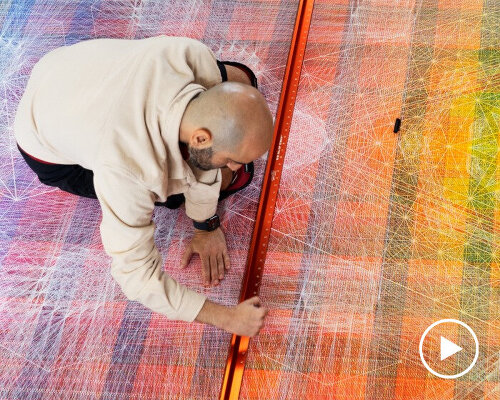roswell2223: an energetic anchor to sunrise at the vortex
Nima Nabavi brings together a constellation of radiant energies that converge with structural order in his solo exhibition Sunrise at the Vortex in Dubai. On view at The Third Line, Roswell2223 forms a gravitational center, laying out a monumental hand-drawn piece that stretches across an 18-foot-long canvas. Saturated with color and encrusted with detail, it distills the core of Nabavi’s practice which seeks to evoke awe, resolve inner resonance, bridge abstraction with emotion, and manifest precise complexities and natural energies through geometry.
Created over the course of a year during a residency in New Mexico, Roswell2223 marks the furthest the Iranian artist has ever pushed the limits of his process. The result is a sprawling, crystalline composition that channels a spiritual intensity and meditative clarity. While the exhibition presents a range of works — some meticulously hand-rendered, others made with the aid of architectural pen plotters — they all maintain a sense of transcendence. Whether plotted by machine or drawn line by line, Nabavi’s geometries work somewhat like elusive discoveries. ‘These patterns, structures and geometries carry a magical appeal that I’m not getting any closer to understanding,’ he tells designboom. ‘It feels more like archaeology to me – I’m finding and exploring these visual phenomena, not inventing them.’ We spoke with the artist to learn more about the methods, philosophies, and intentions behind Roswell2223 and how they resonate with the introspective and technical undercurrents of Sunrise at the Vortex.
all images courtesy of The Third Line
Nima nabavi on the precision and labor of his process
Roswell2223 was created during Nima Nabavi’s time at the Roswell Artist-in-Residence program in the US, where, for the first time, he notes, he had the space and time to expand the bounds of his intricate visual language at such an expansive level. ‘I bought the largest roll of canvas I could find, the biggest ruler I could find (9 feet long), and hundreds of markers in 17 colors,’ he shares with us. ‘I then rolled out the canvas on the floor and started working on the piece line by line.’
He describes this layered and considered process as physically taxing but spiritually immersive, and led partly by chance despite the calculated geometries, as he recalls not knowing exactly how the piece might turn out. ‘I was kneeling, squatting, sitting and bending over for hours on end, but being able to literally sit inside the work and be engulfed by it also brought so much joy.’ The resulting composition measures 18 feet by 6 feet, across which the layers upon layers of lines form a crystalline mapping of the universe that invites viewers, too, to loose themselves in. True to the exhibition’s name, the romantic vibrancy of the work and its motion exudes a sense of soothing energy.
Roswell2223 forms a gravitational center at the exhibition, Sunrise at the Vortex
working between manual and mechanical precision
The surrounding works on view as part of Sunrise at the Vortex further reflect Nima Nabavi’s explorations of the connection between himself and the universe, bringing together works he created in makeshift studios in Roswell, New York, Los Angeles, and Dubai. Some, in contrast to the centerpiece’s laborious methodologies, are machine-assisted and produced using architectural pen plotters, a tool Nabavi only recently incorporated into his practice. Among them, Source Code closely echoes the idyllic, meditative hues of Roswell2223, though on a much smaller canvas.
Within a rounded surface densely marked by over 4 million plotted dots, resembling a sun about to set or rise, the artist notes that there is a level of detail, complexity, and saturation that he would have not have been able to achieve manually. Speaking then on this shift toward the mechanical, he reflects that these plotters are a tool that frees his imagination from the constraints of the hand. ‘It removes arbitrary limitations and opens me up to thinking about my work in a more expansive way,’ he adds. ‘Instead of considering how to reduce my ideas so that they are humanly ‘doable’, I’m expanding my tools to match the ideas… It’s a total paradigm shift – I can use alternate building blocks like curved lines in my works, I can saturate colors like never before, and I’m able to experiment faster.’
a monumental hand-drawn piece stretching across an 18-foot-long canvas
translating energy into structured forms and geometries
This balance between control and joyful discovery pulses throughout the exhibition, which as a whole offers a continuum of experimentation across dualities. Between the intimate and the industrial, and the intuitive and the algorithmic, Sunrise at the Vortex embraces a spiritual luminosity that persists across the show’s various structural forms and scales. Even as Nabavi’s process becomes increasingly complex and precise in these abstract expressions, the work retains an elemental radiance that draws you in.
‘These patterns, structures, and geometries carry a magical appeal that I’m not getting any closer to understanding. It feels more like archaeology to me — I’m finding and exploring these visual phenomena, not inventing them,’ he tells designboom.
the vibrancy of the work and its motion exudes a sense of soothing energy
Nima Nabavi brings together a constellation of radiant energies that converge with structural precision
the creative process was physically taxing but spiritually immersive
‘These patterns, structures and geometries carry a magical appeal’, he says
Source Code echoes the idyllic, meditative hues of Roswell2223, on a much smaller canvas
marked densely by over 4 million dots plotted by a machine
Sunrise at the Vortex reflects Nima Nabavi’s explorations of the connection between himself and the universe
project info:
name: Roswell2223
artist: Nima Nabavi | @nimanothome
location: The Third Line, Dubai
exhibition: Sunrise at the Vortex
dates: 15th June—3rd August 2025
The post behind nima nabavi’s vast geometric vortex painting: converging energy, labor, and structure appeared first on designboom | architecture & design magazine.

